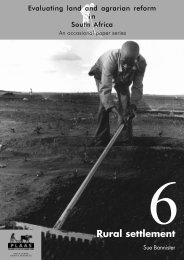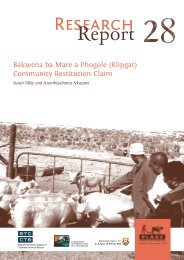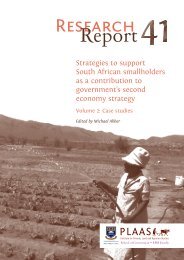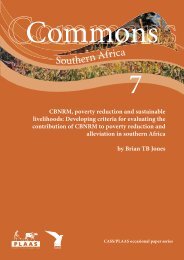A critical appraisal of South Africa's market-based land reform policy
A critical appraisal of South Africa's market-based land reform policy
A critical appraisal of South Africa's market-based land reform policy
You also want an ePaper? Increase the reach of your titles
YUMPU automatically turns print PDFs into web optimized ePapers that Google loves.
A <strong>critical</strong> <strong>appraisal</strong> <strong>of</strong> <strong>South</strong> Africa’s<br />
<strong>market</strong>-<strong>based</strong> <strong>land</strong> <strong>reform</strong> <strong>policy</strong><br />
placing some constraints on the methods<br />
that could be used, mandates <strong>land</strong> <strong>reform</strong>,<br />
allows for expropriation, and allows<br />
compensation at less than full <strong>market</strong> value<br />
(Lahiff & Rugege 2002).<br />
The 1997 White Paper on <strong>South</strong> African<br />
Land Policy sets out a wide range <strong>of</strong><br />
objectives ranging from dealing with the<br />
injustices <strong>of</strong> racially-<strong>based</strong> <strong>land</strong> dispossession,<br />
to promoting economic growth<br />
and providing ‘secure tenure for all’ (DLA<br />
1997:7). The White Paper also states that<br />
the vision is ‘<strong>of</strong> a <strong>land</strong> <strong>policy</strong> and <strong>land</strong><br />
<strong>reform</strong> programme that contributes to<br />
reconciliation, stability, growth and development<br />
in an equitable and sustainable<br />
way’ (DLA 1997:7). The programme<br />
elaborated in the White Paper comprises<br />
redistribution, tenure <strong>reform</strong> and restitution<br />
programmes, as required by sub-sections<br />
25(5), 25(6) and 25(7) <strong>of</strong> the Constitution<br />
respectively.<br />
Restitution sets up a legal and administrative<br />
process, governed by the<br />
Restitution <strong>of</strong> Land Rights Act (Act 22 <strong>of</strong><br />
1994), to restore rights in <strong>land</strong> to people<br />
who can prove that they were dispossessed<br />
<strong>of</strong> such rights after 19 June 1913 due to<br />
racist laws or policies <strong>of</strong> former governments.<br />
The restitution process does not aim<br />
to meet any target for redistribution <strong>of</strong><br />
<strong>land</strong>, and successful <strong>land</strong> claims can be<br />
settled with the return <strong>of</strong> <strong>land</strong>, alternative<br />
<strong>land</strong>, payment <strong>of</strong> cash or another form <strong>of</strong><br />
compensation (DLA 1997:52–7). Land<br />
claims settled so far have not contributed<br />
significantly to unravelling apartheid<br />
spatial planning – the majority <strong>of</strong> claims<br />
have been settled through financial<br />
compensation, not the return <strong>of</strong> <strong>land</strong> (Hall<br />
2003:26, 35).<br />
Tenure <strong>reform</strong> has two distinct aspects<br />
to it, one dealing with improving the<br />
security <strong>of</strong> tenure for those living on other<br />
people’s <strong>land</strong>, primarily farm dwellers on<br />
commercial farms, and the other aimed at<br />
providing legally secure tenure for people<br />
living on communal <strong>land</strong>, primarily in the<br />
former bantustans. A number <strong>of</strong> new laws<br />
have sought to give at least procedural<br />
rights to black farm dwellers, but have<br />
done little to give people their own <strong>land</strong> or<br />
long-term security <strong>of</strong> tenure. The process<br />
<strong>of</strong> developing legislation to deal with<br />
tenure in communal areas dragged on for<br />
years with little progress until the Communal<br />
Land Rights Bill was gazetted in<br />
August 2002 (Government Gazette no.<br />
23740) and later re-gazetted in October<br />
2003 (Government Gazette no. 25562).<br />
The Bill came in for heavy criticism from<br />
<strong>land</strong> activists and academics, but nevertheless<br />
it was passed by Parliament in<br />
February. The Communal Land Rights Act<br />
(Act 11 <strong>of</strong> 2004) was signed into law by<br />
the President on 14 July 2004. It will come<br />
into effect on a date still to be decided<br />
(Claassens 2003; Cousins & Claassens<br />
2003; Sparks 2004).<br />
Post-1994 redistribution<br />
The RDP saw <strong>land</strong> <strong>reform</strong> as ‘the central<br />
and driving force <strong>of</strong> a programme <strong>of</strong> rural<br />
development’ and set a specific target <strong>of</strong><br />
redistributing 30% <strong>of</strong> agricultural <strong>land</strong><br />
within five years (ANC 1994:21–3). This<br />
target was first proposed in the 1993 World<br />
Bank document Options for <strong>land</strong> <strong>reform</strong><br />
and rural restructuring in <strong>South</strong> Africa<br />
(Williams 1996:139–40). The RDP<br />
suggested a range <strong>of</strong> measures for<br />
redistributing <strong>land</strong>, including a <strong>land</strong> tax to<br />
free up <strong>land</strong>, ‘substantial funding’,<br />
expropriation <strong>of</strong> <strong>land</strong>, and provision <strong>of</strong><br />
support services to ensure effective <strong>land</strong><br />
use (ANC 1994:21). The RDP also<br />
suggested other measures that fell outside<br />
the main thrust <strong>of</strong> <strong>market</strong>-<strong>based</strong> <strong>land</strong><br />
<strong>reform</strong> policies, but it did not map out a<br />
path for economic restructuring that would<br />
have been supportive <strong>of</strong> radical <strong>land</strong><br />
<strong>reform</strong>. Statements in the RDP that clearly<br />
fell outside a neo-liberal economic<br />
approach, such as ‘increasing the public<br />
sector in strategic areas through, for<br />
example, nationalisation’, (ANC 1994:80)<br />
quickly disappeared from subsequent<br />
policies.<br />
The White Paper on <strong>South</strong> African Land<br />
Policy sets out a clearly <strong>market</strong>-<strong>based</strong><br />
approach to <strong>land</strong> redistribution: it is to be<br />
demand-led, with a limited role for the state:<br />
10
















